The Plant Operator Selection System (AKA POSS Test) is an aptitude test designed to evaluate the skills and abilities of candidates seeking employment as power plant operators in nuclear, hydroelectric, or fossil fuel power plants.
Here you'll find a free EEI POSS practice test organized into 4 sections: Reading Comprehension, Mechanical Concepts, Mathematical Usage, and Figural Reasoning. Each section includes questions, answers, and helpful tips. The questions are sourced from JobTestPrep's preparation materials and are similar to those on the actual POSS exam.
Since 1992, candidates have trusted JobTestPrep for their test preparation needs. Our seasoned expertise and thorough practice resources will help you achieve top results.
POSS TEST Practice Questions And Answers
Below, you will find questions along with detailed explanations for various sections of the POSS exam.
POSS Mathematical Usage
In the long version of the mathematical usage section, you'll have 17 minutes to answer 46 questions. This test is made up of three parts, including formula conversion problems, algebra problems, and word problems.
X + 14.9 = 7.6, X =?
5
51
-6.5
-7.3
None of the above
The correct answer is (D) -7.3
This question deals with a single-variable equation.
When solving a single variable equation, the goal is to isolate the variable (mostly called x) in order to find its value.
The way to do that is by gathering all variable expressions of the equation (one or more X-expressions) on one side and all numerical members of the equation on the other side. This is done by using the four operations (+, -, *, /) in the equation, as needed.
Important! Any numerical operation must be applied on both sides of the equation.
In this case, isolate X by subtracting 14.9 from both sides of the equation:
X + 14.9 - 14.9 = 7.6 - 14.9
X = -7.3
5 miles/minute = ? feet/second
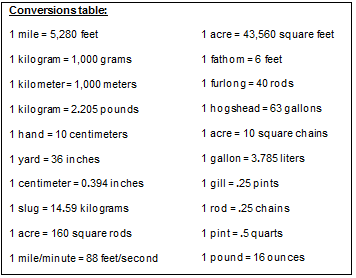
7.33
17.6
320
440
N
The conversion needs to be done is as follows:
According to the table
1 mile/minute = 88 feet/second
To calculate how many feet/second are 5 miles/minute, use the rule of 3:
Therefore,
1 mile/minute = 88 feet/second
5 miles/minute = x feet/second
x = (5*88)/1 = 5*88 = 440
=> 5 miles/minute = 440 feet/second

A. N = 9
B. N = 6
C. N = 27/3
D. N =3


G=RL
G=L/R
G=R/L
G=0.37
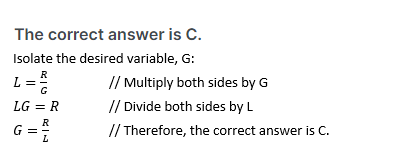
When solving Mathematical Usage problems it's important to divide complex problems into smaller, more manageable parts, it simplifies the problem, making it easier to tackle step-by-step, reducing the chance of errors.
Enhance your math skills and train yourself to solve problems quickly without a calculator with our POSS Mathematical Usage practice tests, available in both short and long versions.
"Outstanding studying material."
William C. On the POSS Test
⭐⭐⭐⭐⭐
-
"Excellent program, took my test and PASSED!! thanks."
John D. On the POSS Test
⭐⭐⭐⭐⭐
-
"..really impressed, wasnt sure what to think beforehand but using the site feels worth the money....The type of problems, length, subjects and time pressure were all slightly harder than the actual test. I was able to refresh on all of the concepts that I needed to and passed with no problem."
Christopher H. On the POSS Test
⭐⭐⭐⭐⭐
-
POSS Mechanical Concepts
In this section of the POSS test, you'll have 20 minutes to answer 44 multiple-choice questions. There are many different mechanical concepts being tested here, including Centrifugal Force, Gears, Gravity, Levers, Pulleys, and Shapes.
In which of the following positions would the tractor be less stable when taking a turn?
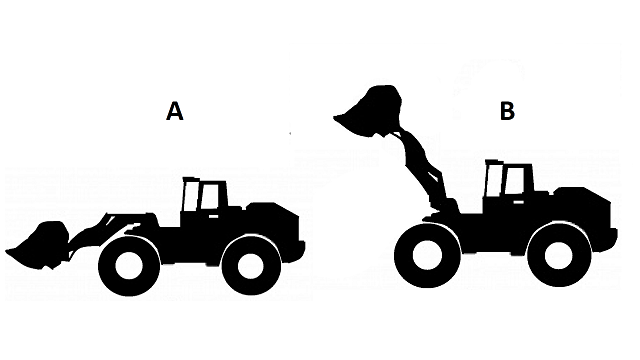
A
B
The Same
As you can see, the only difference between the two figures is the position of the tractor's shovel. In Figure A the shovel is lowered, while in Figure B the shovel is raised.
The raising of the shovel will also raise the point of the center of mass of the tractor. When the center of mass of the tractor is higher, the tractor loses some stability (A good example could be the difference between a semi-trailer and a sports car.
The tall and narrow semi-trailer has a higher point of center of mass and is less stable than the low-lying, flat, and wide sports car which has a lower point of center of mass).
Since in Figure B the shovel is raised, it is less stable. Therefore, choice B is the correct answer.
As you can see, the only difference between the two figures is the position of the tractor's shovel. In Figure A the shovel is lowered, while in Figure B the shovel is raised.
The raising of the shovel will also raise the point of the center of mass of the tractor. When the center of mass of the tractor is higher, the tractor loses some stability (A good example could be the difference between a semi-trailer and a sports car.
The tall and narrow semi-trailer has a higher point of center of mass and is less stable than the low-lying, flat, and wide sports car which has a lower point of center of mass).
Since in Figure B the shovel is raised, it is less stable. Therefore, choice B is the correct answer.
If the left cogwheel rotates in the direction of the arrow, in which direction does the right wheel rotate?
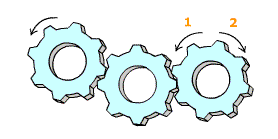
1
2
3
The correct answer is (A) – 1.
The cogwheels turn in opposite directions. When the left wheel turns in the direction of the arrow (counterclockwise), the middle wheel will turn to the right (clockwise). This will cause the right wheel to turn counterclockwise.
At which point does the ball have a greater velocity? (If equal, Mark C.)?
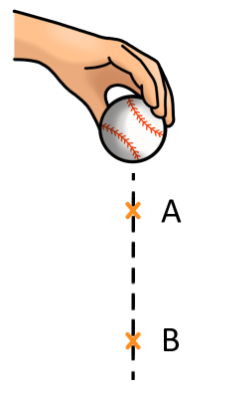
A
B
C
The correct answer is B.
Explanation
The ball is under the effect of gravity, which is a constant acceleration (acceleration – the rate of growth in speed). If the ball accelerates, it means its speed is growing as it travels. Therefore, it will have a greater velocity in point B than in A.
Remember the physical principle: An accelerating body (like a free-falling body) speeds as it travels forward.
Note: Slowing down is also considered acceleration, in the opposite direction to the movement of the body.
When solving mechanical reasoning problems visualize the problem by drawing diagrams or sketches of the mechanical setup the reason is that diagrams help you see the relationships between components, visualize forces, and identify possible solutions more clearly.
Enhance your grasp and practical application of fundamental mechanical and physical principles with our POSS Mechanical Skills practice tests.
"Outstanding studying material."
William C. On the POSS Test
⭐⭐⭐⭐⭐
-
"Excellent program, took my test and PASSED!! thanks."
John D. On the POSS Test
⭐⭐⭐⭐⭐
-
"..really impressed, wasnt sure what to think beforehand but using the site feels worth the money....The type of problems, length, subjects and time pressure were all slightly harder than the actual test. I was able to refresh on all of the concepts that I needed to and passed with no problem."
Christopher H. On the POSS Test
⭐⭐⭐⭐⭐
-
Figural Reasoning
In this section of the POSS exam, you have 10 minutes to answer 20 figural reasoning questions, where you will need to identify patterns to solve problems. The test includes three types of questions: Picture Series, Picture Comparison, and Picture Progression. Here is an example of a Picture Series question.
X is to Y as Z is to ?


The correct answer is 5.
The relationship between figure X and figure Y is as follows:
Figure Y represents figure X as:
1) The inner shape (triangle) rotates 180° and is pushed upward towards the top of the outer shape,
2) The dark section becomes white and the white section becomes dark.
The correct answer must have the same relationship with figure Z.
Answers 2, 3 and 4 can be eliminated as the inner shape (trapezoid) is not rotated.
Answer 1 can be eliminated as the dark section remains dark and the outer shape (the triangle) is rotated 180°.
We are left with answer 5, which is the correct answer, as it portrays figure Z with the inner shape (trapezoid) rotated 180°, the dark sections becoming white, and the white sections becoming dark.
Identify the next figure in the series
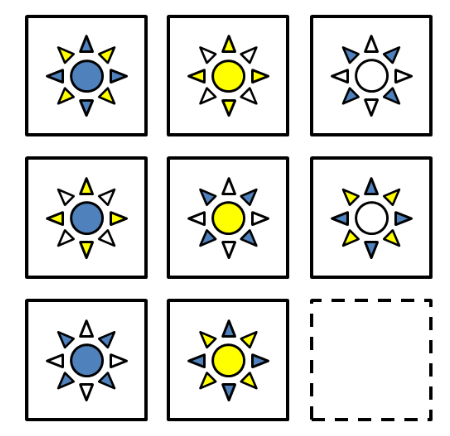

The correct answer is 1.
Down a column, the center of the sun is always the same color. In the right column, the center of the sun is always white. The missing frame is in the right column, it should also have a white center. We can eliminate answer choice 3, because it does not have a white center.
Additionally, notice that across a row, the relation between the center of the sun and the sun’s rays are the same. For example, in the top row, the rays pointing up, down, right and left, are the same color as the center.
In the middle row, the rays and the center of the sun are all different colors. And in the bottom row, the diagonal rays (the ones that are pointing towards the corners of the frame), are the same color as the center of the sun.
Since the missing frame is in the bottom row, it should also have diagonal rays that are the same color as the center. We can further eliminate answer choices 4 and 5, because they have diagonal rays that are not the same color as the sun’s center.
Finally, notice that across a row (and down a column), we never have the same combination of ray colors. We can eliminate answer choice 2, because we already have a sun with blue and white rays, in the top frame of the column, and the left frame of the row.
We are left with answer choice 1, which is the correct answer.
Identify the next figure in the series
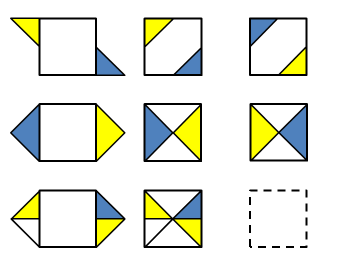

The correct answer is 3.
Take a look at the top row and see how the shapes change across the row. In this question, in the left frame, we have a blue triangle on the right side of the frame, and a yellow triangle on the left side of the frame. In the center frame the triangles flip inwards (as if they were attached to the side and were flipped like the flaps of a box). In the right frame we have a 180° (½ circle) rotation of the center frame.
The same changes will occur in the bottom row. As we can see the triangles that were outside of the left frame, flipped inwards in the center frame. The next (missing) frame should be a 180° rotation of the center frame.
The center frame contains one triangle on the left side where the upper half is yellow and the lower half is white, and another triangle on the right side where the upper half is blue and the lower half is yellow.
After a 180° rotation the white and blue sections should switch. Therefore, we should look for an answer choice that has one triangle on the left where the upper half is yellow and the lower half is blue, and another triangle on the right where the upper half is white and the lower half is yellow.
The only such option is answer choice 3, the correct answer.
When solving figural reasoning questions pay attention to how figures move, rotate, or flip from one step to the next the reason is that many figural reasoning problems involve systematic changes in position or orientation. Understanding these changes can help you determine the next figure or identify the incorrect figure in a series.
Mastering JobTestPrep's POSS Figural Reasoning practice tests will significantly enhance your capability to discern patterns and consistencies among various objects or data sets.
"Outstanding studying material."
William C. On the POSS Test
⭐⭐⭐⭐⭐
-
"Excellent program, took my test and PASSED!! thanks."
John D. On the POSS Test
⭐⭐⭐⭐⭐
-
"..really impressed, wasnt sure what to think beforehand but using the site feels worth the money....The type of problems, length, subjects and time pressure were all slightly harder than the actual test. I was able to refresh on all of the concepts that I needed to and passed with no problem."
Christopher H. On the POSS Test
⭐⭐⭐⭐⭐
-
Reading Comprehension
In this section of the test, you have 30 minutes to answer 36 multiple-choice questions. You are presented with five different passages, and for each passage, you have to answer a number of different questions.
These passages are generally excerpts from power plant operator training and safety manuals.
The Invention of the Light Bulb
"The development of the light bulb is one of the most significant milestones in the history of electricity. Thomas Edison is often credited with the invention of the first practical incandescent light bulb, but the journey to this invention involved many inventors and years of experimentation.
In 1800, Alessandro Volta invented the first electrical battery, known as the voltaic pile, which could produce a steady current of electricity. This invention laid the groundwork for future electrical devices. Humphry Davy, in 1802, created the first electric lamp by connecting voltaic piles to charcoal electrodes, producing a bright arc of light. However, Davy's arc lamp was too intense and impractical for home use.
The next significant advancement came in 1841, when Frederick de Moleyns patented a bulb filled with a vacuum, containing platinum filaments that glowed when electric current passed through them. Despite this advancement, the platinum filaments were costly and inefficient.
Thomas Edison, through extensive experimentation, developed a carbon filament that could glow for hours when heated by an electric current, leading to the creation of a long-lasting and practical incandescent light bulb. On October 21, 1879, Edison's bulb burned for 13.5 hours, a significant improvement over previous designs.
Edison's success was due not only to the invention of the bulb but also to the development of a complete electrical distribution system, which made the widespread use of electric lighting feasible. This system included generators, wiring, and the first commercial power station.
Edison's work laid the foundation for modern electric lighting and power distribution, making it possible for homes and cities to be illuminated by electric light".
In the development of the light bulb, who invented the first electric lamp by connecting voltaic piles to charcoal electrodes?
A. Alessandro Volta
B. Humphry Davy
C. Frederick de Moleyns
D. Thomas Edison
The correct answer is B
The passage states, "Humphry Davy, in 1802, created the first electric lamp by connecting voltaic piles to charcoal electrodes, producing a bright arc of light."
This indicates that Davy was the inventor of the first electric lamp using this method. Alessandro Volta invented the first electrical battery, Frederick de Moleyns patented a bulb with platinum filaments, and Thomas Edison developed the practical incandescent light bulb with a carbon filament.
"Just as the sun’s rays can be focused by a magnifying glass to burn a piece of paper, high-intensity ultrasound waves can be concentrated to burn human tissue. The waves are harmless until they converge at the focal point, so a surgeon can operate deep inside the body without harming the surrounding tissue. HIFU requires no cuts to be made, and many operations don’t even need an anesthetic, so the patient can be in and out of the hospital within a day".
How can HIFU enable early release of patients from hospital?
Ultrasound waves can be very focused.
It allows for very deep penetration into the body.
It is harmless.
No cuts are required.
The correct answer is (D).
According to the last sentence in the passage: "HIFU requires no cuts to be made, and many operations don’t even need an anaesthetic, so the patient can be in and out of hospital within a day."
Answers (A) and (B) are mentioned in the passage, but not as the reason why HIFU enables the patient to be released early. Answer (C) is incorrect, as the passage notes that "the waves are harmless until they converge at the focal point" – they are not always harmless.
"A GHG tax can be levied at any point in the energy supply chain. Most proposals target upstream suppliers of coal, oil, and natural gas as opposed to midstream points (electric utilities or oil refineries) and downstream (energy-using industries, households). Measuring the carbon content of fuels is a straightforward task and there are relatively fewer fuel producers and importers. To be fully inclusive, a downstream tax would have to fall on millions of users, increasing the likelihood that the program's scope would be more limited with higher aggregate and administrative costs".
Why not tax downstream users?
Carbon content is immeasurable
It's administratively more complex
Taxing midstream points is easier
It is technically impossible
The correct answer is (B).
The passage states that "a downstream tax… would be more limited with higher aggregate and administrative costs."
Get POSS Test Preparation
When answering Reading Comprehension questions make notes in the margins, underline key points, and highlight important information as you read the reason is that annotation encourages active reading, helps keep you engaged, and makes it easier to find important information when reviewing the text.
The JobTestPrep POSS Test Reading Comprehension practice tests are designed to enhance your ability to read complex information with precision and speed, ensuring you can effortlessly extract the key details from the passage.
FAQs
As there are a number of different tests that make up the POSS exam, your score on the different components of the exam is combined into an index score ranging from 0 to 15.
Whilst the POSS test is administered by multiple companies, they make their own rules about whether you can take the test again. For example, Duke Energy require a 90 day wait. Make sure you are ready for it with this PrepPack™
The Plant Operator Selection System (POSS) test is made up of four different tests. These are reading comprehension, mechanical concepts, mathematical usage, and figural reasoning.
As the test is marked by computer in theory they could give you your result straight away. However, as there is going to be a pool of candidates, the company usually waits until that pool has all taken their tests and only then give you an answer. In general though, you should be able to get your results within a week of taking the tests.
That’s a difficult question to answer. Made up of four different tests, most people don’t even complete the numerical one. The questions are not overly hard but completing everything within the time limit is taxing. That’s why it’s so important to practice for the tests.
In a word – practice tests under timed conditions. There is no shortcut here and the only way to do yourself justice is to get the pack, take some time and get down to work!




